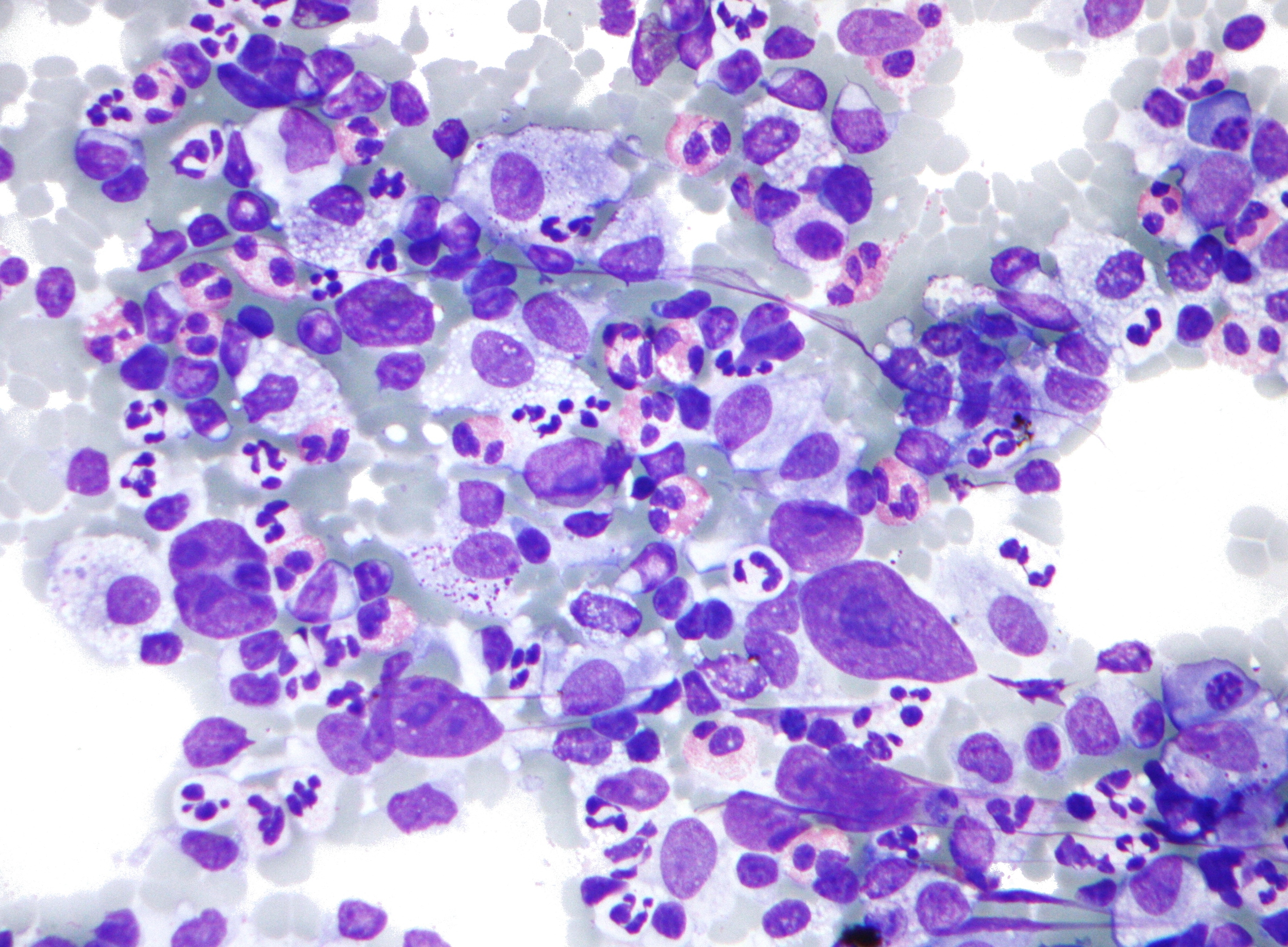Alpine Veterinary Medical Centre is equipped with a plethora of in-clinic laboratory capabilities to assess blood, urine, feces, cytology (cells), and their associated pathologies and parasites. Having an on-site lab gives us the ability to obtain test results very rapidly which has the major advantage of assessing a patient's status quickly and efficiently especially in times when obtaining fast results will have a major impact on the course of emergency treatments. Other advantages for in-house testing include analysis of fresh samples before any degradation has occurred, and the saving of expenses for our clients.
A demodex mite seen under the microscope
Sometimes a particular patient may require more specific tests in which we will need to send samples out for analysis. This may be necessary, for example, in order for a veterinary pathologist abroad to assess the pathology of a tissue sample from a mass, to test for specific pathogens, or for toxicological analysis. We send samples out via Air North courier so that results are available within as little as two days, depending on the type of testing being performed.
Blood Panels
Red blood cells seen in a dog's blood smear
Our in house lab allows us to do a complete blood panel. Having the capacity to analyze blood samples in our lab prevents cell damage due to storage and shipping. A blood panel has two key components: Chemistry and Hematology. Ideally, a blood panel should be performed in every sick patient, every patient with vague clinical signs, every patient undergoing a geriatric or wellness profile, and to recheck patient progress. Most often we do either a Pre-Anesthetic Panel (PAP) or a General Health Panel (GHP).
We use the IDEXX VetLab™ Station, that incorporates 'Laser Cyte' technology to analyze samples. This system employs cell by cell counting, whereby cells are passed through and assessed by the refraction from a laser beam.
A PAP is done whenever a patient is to undergo anesthesia or surgery. Anesthesia can be a risky procedure for patients with certain health conditions such as heart, respiratory, renal, or liver issues, while surgery is especially risky if bleeding disorders are unknowingly present. Thus, it is essential that we screen patients before they undergo anesthesia so that our anesthetic protocol can be modified to meet the specific needs of each patient. A PAP only includes the parts of the Chemistry and Hematology necessary for anesthetic and surgical screening.
On the contrary, a GHP includes a complete Chemistry and Hematology that may help identify a broad spectrum of potential medical issues. This is usually recommended when we are examining a patient that has a sickness of unknown origin or for senior patients.
The IDEXX VetLab™ also enables us to do more specific tests. Addison's and Cushing's are adrenal gland diseases diagnosed via assessment of the hormone cortisol. Thyroid dysfunction is evaluated via Thyroxine T4 quantification. Parvovirus can be tested with a snap analysis of feces for the virus. Amylase, lipase, total bilirubin, and creatine can indicate abnormal pancreatic or hepatic conditions.
Urinalysis
When a patient is suspect of having a urinary tract infection, having trouble urinating, or is incontinent, we perform an in-house urinalysis to try to further characterize what the problem is so that we can derive a treatment strategy. A urinalysis includes:
- Physical characterization: color, odor, turbidity, specific gravity.
- Urine reagent sticks: to quantify leukocytes, nitrate, urobilinogen, protein, pH, blood, ketones, bilirubin and glucose.
- Microscopic examination: to classify and quantify red and white blood cells, epithelial cells, crystals, bacteria, fat droplets, and casts.
- Urine culture is performed by incubating urine for 48 hours to quantify and identify bacteria involved in infections.
Fecal Exam
When a patient is suspect of having acquired a gastro-intestinal parasite, such as worms, flukes, giardia, or coccids, we conduct a microscopic examination of the feces to determine the specific pathogen involved. Under the microscope we can find various life cycles ranging from the egg, larvae, or adult form of these parasites.
Cytology
Sample taken from a lipoma, a benign fat tumor
Often the best way to determine the cause of a dermatological problem, mass or internal body cavity fluid accumulation is to examine the cells with special stains under the microscope.
For dermatological cases we may take a skin smear or a skin scraping and examine the thin layer of cells on a slide microscopically.
We conduct Fine Needle Aspirates (FNA) to investigate masses, tumors, and cavity fluids before proceeding with treatment. For instance, some benign masses may not need any treatment, whereas cancerous masses need to be approached carefully in order to ensure that sufficient margins are removed and that cancerous cells are not seeded throughout the body. A FNA can help determine the type of cells involved in a mass, thereby giving us a better idea of the appropriate next diagnostic or therapeutic steps.
During a FNA, a needle is inserted into the mass and a sample of the cells or fluid is aspirated into a syringe. This sample is then assessed microscopically at our in-house laboratory.
Blood Glucose/ Diabetes
When a patient is suspected or diagnosed with diabetes we take small pricks of blood to assess glucose levels. When deriving a treatment strategy for diabetes, multiple blood glucose samples are taken over a period of days and weeks to establish a blood glucose curve. This curve provides us with the information needed to decide on a treatment protocol for our diabetes patients.
Fungassay/ Ringworm
When ringworm is suspected in a patient we can aid our diagnosis with the help of a lab test called a fungassay. Ringworm is caused by a skin fungus (Dermatophyte) which we can identify using a test medium that changes color with a positive finding.
Blood Panel Interpretation
Blood Chemistry
Albumin (ALB) - Decreased levels of this liver protein suggest chronic liver, kidney or intestinal disease.
Alanine Aminotransferase (ALT) - An enzyme that increases during liver trauma or disease.
Alkaline Phosphatase (ALKP) - A liver and bone enzyme in which elevated levels suggests liver disease, Cushing's, or steroid treatment.
Amylase (AMYL) - An enzyme secreted by the pancreas that aids in digestion. Increased levels suggest pancreatic disease.
Blood Urea Nitrogen (BUN) - This is produced by the liver and excreted by the kidneys. Elevated levels suggest kidney disease or dehydration. Decreased levels may be indicative of liver malfunction.
Calcium (Ca2+) - Parathyroid gland and kidney disease, as well as some tumours, can be diagnosed, in part, via elevated calcium levels in the blood.
Cholesterol (CHOL) - Increased levels may be associated with a variety of disorders including hypothyroidism, liver or kidney disease.
Creatinine (CREA) - This is a muscle metabolism by-product excreted by the kidneys. Increased levels suggest kidney disease, urinary tract obstruction or dehydration.
Blood Glucose (GLU) - High levels suggest diabetes. In cats, high levels can also be confused with stress. Low levels suggest liver disease, infection, or some types of tumours.
Phosphorus (PHOS) - High levels are indicative of kidney disease.
Total Bilirubin (TBIL) - This is a component of bile, as well as a breakdown product of hemoglobin. High levels in the blood suggest liver disease and can help distinguish between forms of anemia.
Total Protein (TP) - Dehydration, diseases of the liver, kidney or intestine, and various other conditions can be indicated by elevated blood protein.
Hematology
White blood cells are the cellular components of the immune system. The cells listed below are different types of white blood cell parameters that are found on our blood panels. Inflammation, infection, stress, certain tumour types, immune disorders and other conditions may be occurring when their levels diverge from their expected range.
White Blood Cells (WBC)
Lymphocytes (LYM)
Monocytes (MONO)
Neutrophils (NEU)
Eosinophils (EOS)
Basophils (BASO)
The following relate to the quantity, size, distribution and hemoglobin content of red blood cells within the blood. Low levels suggest anemia which may be due to disease or blood loss. High levels are often due to dehydration.
Red Blood Cells (RBC)
Hemoglobin (HGB)
Reticulocytes (RETIC)
Mean Corpuscular Volume (MCV)
Red Blood Cell Distribution Width (RDW)
Mean Corpuscular Hemoglobin Concentration (MCHC)
Hematocrit (HCT)
The following parameters relate to the quantity and size of platelets within the blood. Both increases and decreases may indicate bleeding or clotting disorders. Abnormally high or low levels can also suggest leukemia.
Platelets (PLT)
Mean Platelet Volume (MPV)
Platelet Distribution Width (PDW)
Electrolytes
Electrolytes are vital components of a patient's health. Imbalances may relate to vomiting, diarrhea, dehydration, Addison's disease, or heart problems.
Sodium Na+
Potassium K+
Chloride Cl-
Thyroid Hormone
Thyroxine T4 - This describes the amount of thyroid hormone in the blood. Since thyroid disease can have serious health impacts, it is important to test your pets, especially older cats.




